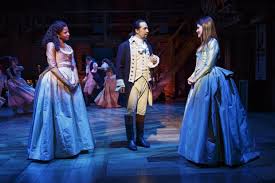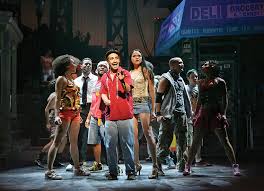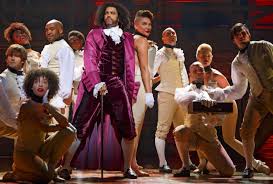In the wake of the recent casting controversies over Katori Hall’s The Mountaintop and Lloyd Suh’s Jesus in India, there have been a number of online commenters who have cited Lin-Manuel Miranda’s musical Hamilton as a justification for their position in the debate. What’s intriguing is that Hamilton has been offered up both as evidence of why actors of color must have the opportunity to play both characters or color and characters not necessarily written as characters of color – but it has also been used to say that anything goes, and white actors should be able to play characters of color as well.
In the Broadway production of Hamilton, the characters are historical figures who were all known to have been white, but they are played by actors of many races and ethnicities, notably black, Latino and Asian. My position on non-traditional (or color-blind or color-specific) casting is that it is not a “two-way street,” and that the goal is to create more opportunities for actors of color, not to give white actors the chance to play characters of color.
As it happens, I had an interview scheduled with Miranda last week, the night before Thanksgiving. Race wasn’t the subject at all, however. We were speaking about his experiences in, and views on, high school theatre, for Dramatics magazine, a publication of the Educational Theatre Association (ask a high school thespian for a copy). But when I finished the main interview, and had shut off my voice recorder, I asked Miranda if he would be willing to make any comment regarding the recent casting situations that had come to light. He was familiar with The Mountaintop case, but I had to give him an exceptionally brief précis of what had occurred with Jesus in India. He said he would absolutely speak to the issue, and I had to hold up my hand to briefly pause him as he rushed to start speaking, while I started recording again.
“My answer is: authorial intent wins. Period,” Miranda said. “As a Dramatists Guild Council member, I will tell you this. As an artist and as a human I will tell you this. Authorial intent wins. Katori Hall never intended for a Caucasian Martin Luther King. That’s the end of the discussion. In every case, the intent of the author always wins. If the author has specified the ethnicity of the part, that wins.
“Frankly, this is why it’s so important to me, we’re one of the last entertainment mediums that has that power. You go to Hollywood, you sell a script, they do whatever and your name is still on it. What we protect at the Dramatists Guild is the author’s power over their words and what happens with them. It’s very cut and dry.”
This wasn’t the first time Miranda and I have discussed racial casting. Last year, we corresponded about it in regard to high school productions of his musical In The Heights, and his position on the show being done by high schools without a significant Latino student body, which he differentiated from even college productions.
“The joy of In The Heights runs both ways to me,” he wrote me in early 2014. “When I see a school production with not a lot of Latino students doing it, I know they’re learning things about Latino culture that go beyond what they’re fed in the media every day. They HAVE to learn those things to play their parts correctly. And when I see a school with a huge Latino population do Heights, I feel a surge of pride that the students get to perform something that may have a sliver of resonance in their daily lives. Just please God, tell them that tanning and bad 50’s style Shark makeup isn’t necessary. Latinos come in every color of the rainbow, thanks very much.
“And I’ve said this a million times, but it bears repeating: high school’s the ONE CHANCE YOU GET, as an actor, to play any role you want, before the world tells you what ‘type’ you are. The audience is going to suspend disbelief: they’re there to see their kids, whom they already love, in a play. Honor that sacred time as educators, and use it change their lives. You’ll be glad you did.”
Anticipating the flood of interest in producing Hamilton once the Broadway production and national tours have run their courses, I asked Miranda whether the acting edition of the script of Hamilton will ultimately be specific about the cast’s diversity, and whether, either at the college level or the professional level, he would foresee a situation where white actors were playing leading roles.
“I don’t have the answer to that. I have to consult with the bookwriter, who is also me,” he responded. “I’m going to know the answer a little better once we set up these tours and once we set up the London run. I think the London cast is also going to look like our cast looks now, it’s going to be as diverse as our cast is now, but there are going to be even more opportunities for southeast Asian and Asian and communities of color within Europe that should be represented on stage in that level of production.
“So I have some time on that language and I will find the right language to make sure that the beautiful thing that people love about our show and allows them identification with the show is preserved when this goes out into the world.”
Authorial intent, y’all. Authorial intent.
Howard Sherman is interim director of the Alliance for Inclusion in the Arts and director of the Arts Integrity Initiative at The New School College of Performing Arts.







Just in time! My wonderful 11 and 16 year old nieces who love theater, do theater, and love Hamilton sent me this link because they thought it was “so funny”.uTube:
https://youtu.be/aP5pVWGVJ30
I thanked them and then texted their mom, my sister, Latina like me, and said, “I’m having a hard time with this. I know the high schoolers were being funny, but it tripped my wire of sensitivity re:casting and Latino sterotypes. She didn’t see it the same way and honestly, I’m questioning if I overreacted. Your article / Lins thoughts give me more to consider. Thank you!
Funny stuff, creative kids. I thought it was not so much a stereotype of Latinos, but more a parody of someone who clearly isn’t an actor. The director trying to get him and also “Peggy” to engage is hilarious.
At one point in the article, Sherman
says: “My position on non-traditional (or color-blind or color-specific) casting is
that it is not a “two-way street,” and that the goal is to create more
opportunities for actors of color, not to give white actors the chance to play
characters of color.”
Then he finishes by saying:
“Authorial intent, y’all. Authorial intent.”
You can’t have it both ways, Sherman. Which is it?
My final comment was obviously too glib, though I don’t revise my posts once they’re up. But I’m glad you pointed this out. As I’ve written previously, so long as works are under copyright, changes must be approved by the author, their estate or the licensor. That said, I do hope that approval will be given to allow more diversity. For works out of copyright, anything goes.
But, like, im a white guy, and I wanna be Hamilton. Can I do that?
No. Capable white actors will not be considered. You will not even be seen. They don’t hire YOUR kind.
You are WRONG! Cast should be hired based on talent, but I should be historically accurate. Character should be in costume & Make up should be racially accurate (white face/black face) as needed. Other wise I will read the book, but avoid the play
[…] And finally, a few days ago Howard Sherman, the man behind the Youtube channel that hosts most of the Ham4Ham shows, interviewed Lin about race in casting not only in Hamilton but in the recent controversy surrounding the casting of a white man as Martin Luther King, Jr. in The Mountaintop. “When I see a school production with not a lot of Latino students doing [In the Heights], I know they’re learning things about Latino culture that go beyond what they’re fed in the media every day. They HAVE to learn those things to play their parts correctly. And when I see a school with a huge Latino population do Heights, I feel a surge of pride that the students get to perform something that may have a sliver of resonance in their daily lives.” A really interesting piece worth reading over at Howard’s site. […]
[…] http://www.hesherman.com/2015/12/03/what-does-hamilton-tell-us-about-race-in-casting/ […]
[…] In the wake of the recent casting controversies over Katori Hall’s The Mountaintop and Lloyd Suh’s Jesus in India, there have been a number of online commenters who have cited Lin-Manuel Miranda’s musical Hamilton as a justification for their position in the debate. What’s intriguing is that Hamilton has been offered up both as evidence of why actors of color must have the opportunity to play both characters or color and characters not necessarily written as characters of color – but Continue reading… […]
How can one say “authorial intent” and then say he doesn’t know yet what his intent is? If his intent was clear, one would think he would already know how he feels about the long term casting of the show and rights.
When will your interview with Miranda be in Dramatics magazine?
My interview with Lin, which focuses on his personal experiences in high school theatre, is slated for their March issue. This material was not part of that main interview; it might appear in a sidebar, but I’m being edited next week.
[…] Miranda supported playwright Katori Hall when she objected to a Kent State production of her play The Mountaintop featuring a white actor playing Martin Luther King Jr. Miranda said that authorial intent must […]
[…] Miranda supported playwright Katori Hall when she objected to a Kent State production of her play The Mountaintop featuring a white actor playing Martin Luther King Jr. Miranda said that authorial intent must […]
I wonder why instead of creating black characters to get more roles for PoC they used preexisting white characters? I not sure I have issue with the mix racial casting but it seems odd to use that as your explanation for your casting choices. Create more roles for PoC instead of using white characters. Otherwise I say all bets are off and anyone can play anyone.
Because if you write a play about joe anybody there will not be much interest in it and you will not be able to sell tickets.
I think part of his rationale is that even if these men and women were historically white, the impulse that drove the revolution was decidedly alternative, progressive, and “New York”. If the Revolution were to occur today, in New York – as it did historically, its language would be rap and the main organizers of the movement would be minorities.
Rap because the language is all at once subversive and poetic – as the letters and papers (the Federalist Papers) of the day were. Minority because the Revolution was particularly urban and because at the time “Americans” were minorities in the face of the Empire. Because New York was diverse in many ways. The revolutionaries came from all walks of life (not just the elite). There may have been little racial diversity in the historical narrative (or I should say that the diversity that was there is historically erased), but there was class and status diversity. For the time, that was very significant.
The casting also creates a postmodern narrative that lives unspoken in the play. When the viewer sees Jefferson played by a black man, one sees clearly the contradiction he presents. A man who still “owned” his children as slaves until his death… A man who brilliantly carved a path for democracy in the US – is played by a black man. Someone who in another time could have very well been enslaved by the founders. That is unspoken commentary on our complicated history and “founders”. Personally, I do not think the play would be the same narrative at all without a minority cast playing these historically white characters. It would make the same statements.
The cast is not playing white, they are commenting on whiteness, class, status, gender and opportunity in the US both then and now.
I think he has really opened up a new way of thinking about not just race and history, but really about social movements in modern times. Its a brilliant turn.
I’m clear on the concept of “authorial intent” but especially with the “non-white” casting call recently for Hamilton, is that clear enough guidance? Is something as generic as “anything but white” enough? Should a biracial person who reads as white not even consider auditioning despite their racial heritage? Should a Caucasian person who reads as an ethnic be encouraged to audition? With the casting traditions for the show already, should a person of another minority ethnicity other than black or Latino consider auditioning?
And why has the role of King George repeatedly been cast with out gay men (Groff, Rannells, O’Malley)? I mean, on behalf of the gay community, I appreciate sexual orientation blindness in casting, but are the producers implying something more there?
[…] For the benefit of all of the teachers (and students) who weren’t there, here are some highlights from Miranda’s remarks, slightly condensed and edited for clarity. Among the material not included here are any topics covered in my prior interviews with Miranda, both for Dramatics magazine and this website. […]
I saw a performance at my local college of some historical play and a black woman was cast in the lead. It just didn’t work for me.
[…] 4http://www.hesherman.com/2015/12/03/what-does-hamilton-tell-us-about-race-in-casting/ […]
Part of this author’s statement illustrates the ‘race’ problem…” My position
on non-traditional (or color-blind or color-specific) casting is that
it is not a “two-way street,” and that the goal is to create more
opportunities for actors of color, not to give white actors the chance
to play characters of color.” WHY? Why not a “two way street”? If one is truly set on the need for “color blind casting” why not truly honor the goal and allow this to be a “two way street”. THIS is exactly part of the problem. It’s never a two way street….and never will be until we decide its to be and act accordingly.